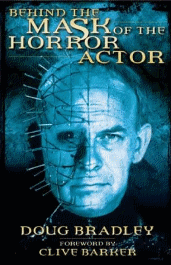|
Find interviews by: | ||
Behind the Mask of the Horror Actor by Doug Bradley Titan Books, 2004, paperback, £10.99/$14.95
Although nominally divided into five parts, there are really three sections to the book. Part One is a look at the history of the mask in performance, from ancient shamans through classical Greek theatre to Comedia dell’Arte and Japanese No. It’s an interesting if necessarily compressed overview of the subject. Parts Two to Four are case studies of heavily made-up horror film roles and the actors who played them, divided chronologically into ‘The Silent Era’, ‘The Golden Age’ and ‘The Fifties and Sixties’. The usual suspects are present - Karloff, Laughton, Chaney pere et fils - and the make-up men who worked on them are also featured, including the legendary Jack Pierce who created all the classic Universal Studios monsters in the 1930s. Although a few factual errors slip in (wheelchair bound Peter Lorre did not play Dracula in the Route 66 episode for which he, Karloff and Chaney Jr recreated their classic roles; Dr Phibes was not Vincent Price’s only heavily made-up role after House of Wax) on the whole Bradley presents a well-researched and accessible guide to his illustrious predecessors. The Hollywood monsters having been well-documented elsewhere, many readers of this book will already know their stories to some extent but it is intriguing to find the subject approached by an actor, whose take on it all is naturally different from that of a film historian. Nevertheless, by dint of unfamiliarity, the highlight of this section is the chapter on Jean Marais’ performance in Cocteau’s La Belle et la Bete. The third and longest section, Part Five accounting for nearly half the book, is Bradley’s own story from his schooldays in Liverpool through the years of increasingly outre fringe theatre with a troupe led by his friend Clive Barker (who contributes a foreword to this book). This is good stuff, and not just because it confirms in print something which I have been telling people for years, to general disbelief: that the first incarnation of Barker and Bradley’s theatre company included a pre-Family Fortunes Les Dennis! Alternating with Bradley’s autobiographical account are examinations of, and interviews with the men behind, those other undying masked/made-up maniacs de nos jours: Michael Myers, Jason Vorhees, Leatherface and Freddy Krueger. These chats with actors whom Bradley has befriended on the convention circuit are placed in their chronologically correct positions so that we have some understanding of what the author himself experienced when his most famous role entered his life and transformed his career. Doug Bradley is and ever shall be Doug (Pinhead from Hellraiser) Bradley and he seems entirely at ease with this. From the creation of the original Hellraiser film in 1987 to the developments of Parts II, III and IV, we see the character come to life through Bradley’s own unique vantagepoint, on the inside of that iconic make-up. He writes lucidly and honestly, with much due acknowledgement of the skill of make-up supremo Bob Keen and his team, and it’s a tale which will hold the interest of not just the rabid horror-fan but also anyone with ambitions to enter the acting or make-up professions. Apart from the Hellraiser films, Bradley dwells briefly on his heavily made-up roles in Nightbreed and Proteus and acknowledges his rare unmade-up role in The Killer Tongue. For this new edition a penultimate chapter has been inserted covering his voice work on the British animations Archangel Thunderbird and Dominator, his roles in the award-winning short films On Edge and Red Lines - and four more Hellraiser films. With Pinhead becoming little more than a stock monster, it is intriguing to find out why an actor of Bradley’s calibre continues to make increasingly token appearances in decreasingly budgeted straight-to-video sequels. Very simply, he has a possessive affection for the character and knows that if he turns down the work, the role will go to someone else and be ruined. Fascinating and eminently readable as this book is, there are two criticisms which can be made. The first is that, apart from the final chapter, no attempt has been made to revise the existing text leading to (among other things) some oddly anachronistic references to things that happened “this century.” When I updated Neil Gaiman’s Don’t Panic for Titan three years ago I checked for such things in the existing text and it’s a shame that the same was not done here as it spoils the ship for a hap’orth of tar. The second, slightly bigger problem - though not big enough to make this anything less than a thoroughly enjoyable read - is that the three sections described above sit awkwardly together. Bradley does not expand on his discussion of shamans and Comedia dell’Arte to offer insight into the work of horror actors, nor do we see any clear lineage from the work of Karloff and Jack Pierce to that of the author and Bob Keen. Frankly, it feels like Behind the Mask of the Horror Actor has been stitched together from parts of three different books. Which, for a volume with a photo of the Frankenstein monster on the back cover, is perhaps appropriate. But it at Amazon.com or Amazon.co.uk | ||

